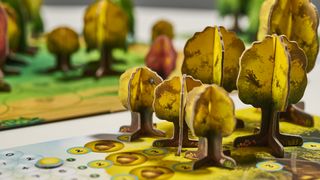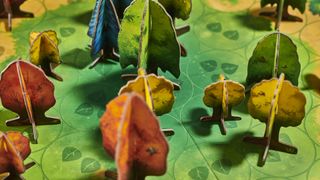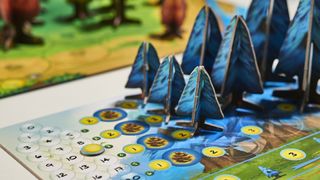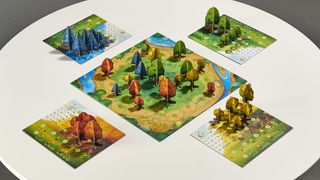Photosynthesis is a rare blend you find in only the best board games: a very simple game with deep strategy that also perfectly evokes its theme. As the title implies, that theme is trees growing in the sunlight.
The more trees you have, the more light they capture and the more you can grow new seedlings. But you can’t keep growing more trees forever: to score you must sacrifice a full-grown tree, in a neat simulacrum of the circle of life.
Photosynthesis has been a big hit with modern board game fans, and is starting to find a home with more casual players. And that's well deserved, because this kind of easy-to-learn, great-looking game should have wide appeal.
And there's more here than just looks – experienced players will find there's a layer of strategy to the game that's very rewarding for those who grow with it.
- The top new board games of 2020
- Best board games for two players
- Best board games for kids
- Best cheap board games
Photosynthesis board game: Price and who it's for
The game comes with a lot of cardboard trees that you have to punch out and slot together. They look fantastic in play; a bonsai forest growing on your tables. So the asking price of around £35/$40 seems very reasonable. And the whole family can enjoy the spectacle as the suggested age of 10+ seems right on the money, and each game takes about fifteen minutes per player to play.
It also scales well from the two to four players it accepts, although three is probably the sweet spot. The rules are logical and straightforward with a clear cause and effect path, so they’re not difficult to learn. Like Chess, though, the game has no random elements, so success depending entirely on planning ahead. Players who prefer lighter, more chaotic fare like party games may find this a turn-off, but it's not too much of a brain-twister, and isn't intimidating in any way.

Photosynthesis board game: How it plays
Each player starts the game with a solitary small tree of their type on the board, and a supply of trees and seeds they'll be able to add to the board over time. On your first turn, that tree will collect one light point from the sun, which you'll probably then use to plant a new seed.
On later turns, you can spend larger amounts of light to grow seeds into small trees or increase the size of existing trees. Bigger trees can then collect more light, increasing your options.
The board has highlighted zones which score higher points for trees the closer they are to the centre. So the initial turns are a race for the best scoring spots. But at the same time, trying to gobble up all the space as fast as possible is a risk. You’ll soon run out of trees, meaning you have to use some of your light to buy more. And you won’t be growing your trees taller if you're spending all your points to make new ones, which leaves you at the mercy of the game’s very novel method of interaction.
Each turn, the sun (represented by a large token) moves to a new spot on the board, rotating around the board one side at a time. You then draw a line from the position of the sun across the board to see which trees are in a position to soak it up and get light points.
Trees hidden behind other trees will only get the light if they’re taller than the one in front, otherwise they're stuck in the shade, and don't earn any light point for you. Taller trees, in turn, cast a shadow further back, blocking precious light from more competitors behind them. As a result, racing to cover ground with lots of small trees isn’t always the best option.

This is how the game unfolds: the sun and the turn order follow a fixed path. It’s up to you to identify what spots will be in sun and which in shadow, second guess other player’s moves and plan accordingly. You’ll need to balance getting light for yourself against blocking it from others, as well as access to the best scoring spaces. It’s a game that rewards logical thought and organization, but even when you’ve got that down, there’s another catch.
Growing trees is all very well, but at some point, you have to sacrifice them to get them to score – in this case, that means removing a tree from the board, leaving its spot empty. Before you can sacrifice a tree, it has to be full-grown (ie, the tallest of the three stages), and you only ever have two full-grown tree pieces to play with. Timing it so you can get both on the board, and have a mid-size tree ready to grow when one gets sacrificed and you get the piece back is a tricky art.
All the more so because as soon as that big tree gets recycled into points, two things happen. First, it’s no longer casting its long shadow on the board, giving lots of other trees a chance to catch the light and grow. Second, you’ve just lost a major source of light yourself. So it’s a double whammy, reducing your ability to grow while increasing that of other players. But if you want to win, you’ve got to do it. And in a further twist, earlier trees get more points, creating another awkward tension between scoring now and scoring later.

As you’ve likely noticed, the game does an outstanding job of capturing its title. The way more trees capture more light allowing your species to thrive creates a beautiful, circular mimic of a real ecosystem on the board, and this also makes it easier to teach – everything just makes sense to people because it fits with real life.
The strategy is also pleasingly circular, forever catching the players in a bind of competing priorities. It’s fitting, then, that the board itself is also a circle and the trees create a vibrant tabletop woodland to enjoy.
But for all its autumnal color, Photosynthesis can be dry and deterministic. It’s often possible to see who’s going to win a turn or two in advance. Only some secret scoring discs put it in doubt, and even they follow a fixed order so veteran players will still know the score. Said discs are also a bit of a pain to put in order when you want to set up each new game.
This is not a thrill a minute game, but is more about the satisfaction of building your woodland over time, and pulling off the occasional tactical coup. And younger or newer players will be at a significant disadvantage compared to old hands, though that won't stop them enjoying playing – again, there's pleasure in the building, not just the winning.

Photosynthesis board game: Verdict
Simple to learn, quick to play and attractive to look at, Photosynthesis deserves to be a big hit. It's worth remembering that it's a game that can be tough on the players if approached with merciless competitiveness by more experienced players – without any randomness there’s nowhere for weaker players to hide, and the only way to do better is to think harder – but some will also prefer that luck can never turn against you in it.
But if you're up for the challenge, or are happy to build develop something attractive regardless of winning or losing, it will prove very rewarding while also being very accessible.
Photosynthesis board game: Also consider
A game with a similar feel but which offers more variety is Santorini. This is another logical game where players race to build and climb towers while blocking their opponent from doing the same. There’s a raft of easy special powers for the players that make each game different. It’s best with two, though, as there’s lots of head to head competition: playing with more means playing as a team.
For families or younger players, check out Kingdomino and its more complex cousin Queendomino. In both games, players build a kingdom by connecting colorful domino pieces, trying to get big areas of the same type of land together. You can see which pieces are up for grabs a turn in advance, but the better the piece you choose, the later in the order you’ll be for choosing next turn, giving it an additional element of skill.



